Thermography-Based Deterioration Detection in Concrete Bridge Girders Strengthened with Carbon Fiber-Reinforced Polymer
Abstract
:1. Introduction
2. Methods
2.1. Pulsed Heating Response
2.2. Thermal Contrast and Signal-to-Noise Computation
2.3. Post-Processing Technique: Thermal Signal Reconstruction
2.4. Post-Processing Technique: Pulsed Phase Thermography
3. Experimental Procedure
3.1. Specimen Implementation
3.2. Experimental Work
4. Discussion of Results
4.1. Detection of Delamination
4.2. Effect of CFRP on Delamination Detection
4.3. Prediction of Delamination Depth
4.4. Enhancement of Delamination Detection Using Post-Processing Algorithms
5. Conclusions
Author Contributions
Funding
Conflicts of Interest
References
- Hiasa, S.; Birgul, R.; Catbas, F.N. Investigation of effective utilization of infrared thermography (IRT) through advanced finite element modeling. Constr. Build. Mater. 2017, 150, 295–309. [Google Scholar] [CrossRef]
- Tran, Q.H. Quantitative Evaluation of Deteriorations for Concrete Bridge Structures using Square Pulse Thermography. Ph.D. Thesis, Chonnam National University, Gwangju, Korea, 2019. [Google Scholar]
- Hiasa, S. Investigation of Infrared Thermography for Subsurface Damage Detection of Concrete Structures. Ph.D. Thesis, University of Central Florida, Orlando, FL, USA, 2016. [Google Scholar]
- Chen, F.; Baji, H.; Li, C.-Q. A comparative study on factors affecting time to cover cracking as a service life indicator. Constr. Build. Mater. 2018, 163, 681–694. [Google Scholar] [CrossRef]
- Su, R.K.L.; Zhang, Y. A double-cylinder model incorporating confinement effects for the analysis of corrosion-caused cover cracking in reinforced concrete structures. Corros. Sci. 2015, 99, 205–218. [Google Scholar] [CrossRef] [Green Version]
- Zhang, Y.; Su, R.K.L. Concrete cover delamination model for non-uniform corrosion of reinforcements. Constr. Build. Mater. 2019, 223, 329–340. [Google Scholar] [CrossRef]
- Xi, X.; Yang, S. Time to surface cracking and crack width of reinforced concrete structures under corrosion of multiple rebars. Constr. Build. Mater. 2017, 155, 114–125. [Google Scholar] [CrossRef] [Green Version]
- Klaiber, F.W.; Dunker, K.F.; Wipf, T.J.; Sanders, W.W. Methods of Strengthening Existing Highway Bridges, Report 293; National Cooperative Highway Research Program: Ames, IA, USA, 1988. [Google Scholar]
- Chajes, M.; Rollins, T.; Dai, H.; Murphy, T. Report on Techniques for Bridge Strengthening, FHWA-HIF-18-041; University of Delaware: Newark, NJ, USA, 2019. [Google Scholar]
- ElSafty, A.; Graeff, M. The Repair of Damaged Bridge Girders with Carbon-Fiber-Reinforced Polymer “CFRP” Laminates, BDK82 977-03; University of North Florida: Jacksonville, FL, USA, 2012. [Google Scholar]
- ACI Committee 440 440.2R-17: Guide for the Design and Construction of Externally Bonded FRP Systems for Strengthening Concrete Structures; American Concrete Institute: Farmington Hills, MI, USA, 2017.
- Tashan, J.; Al-Mahaidi, R. Bond defect detection using PTT IRT in concrete structures strengthened with different CFRP systems. Compos. Struct. 2014, 111, 13–19. [Google Scholar] [CrossRef]
- Vaghefi, K. Infrared Thermography Enhancements for Concrete Bridge Evaluation. Ph.D. Thesis, Michigan Technological University, Houghton, MI, USA, 2013. [Google Scholar]
- Huh, J.; Mac, V.H.; Tran, Q.H.; Lee, K.-Y.; Lee, J.-I.; Kang, C. Detectability of Delamination in Concrete Structure Using Active Infrared Thermography in Terms of Signal-to-Noise Ratio. Appl. Sci. 2018, 8, 1986. [Google Scholar] [CrossRef] [Green Version]
- Forde, M. International practice using NDE for the inspection of concrete and masonry arch bridges. Bridg. Struct. 2010, 6, 25–34. [Google Scholar] [CrossRef]
- ASTM D4788-03, Standard Test Method for Detecting Delaminations in Bridge Decks Using Infrared Thermography; ASTM International: West Conshohocken, PA, USA, 2013. [CrossRef]
- Zhang, H.; Yang, R.; He, Y.; Foudazi, A.; Cheng, L.; Tian, G. A Review of Microwave Thermography Nondestructive Testing and Evaluation. Sensors 2017, 17, 1123. [Google Scholar] [CrossRef]
- Maldague, X. Theory and Practice of Infrared Thermography for Nondestructive Testing; John Wiley & Sons, Inc.: New York, NY, USA, 2001. [Google Scholar]
- Milovanovic, B.; Pečur, I.B. Review of Active IR Thermography for Detection and Characterization of Defects in Reinforced Concrete. J. Imaging 2016, 2, 11. [Google Scholar] [CrossRef]
- Janků, M.; Cikrle, P.; Grošek, J.; Anton, O.; Stryk, J. Comparison of infrared thermography, ground-penetrating radar and ultrasonic pulse echo for detecting delaminations in concrete bridges. Constr. Build. Mater. 2019, 225, 1098–1111. [Google Scholar] [CrossRef]
- Tashan, J.; Al-Mahaidi, R. Detection of cracks in concrete strengthened with CFRP systems using infra-red thermography. Compos. Part B Eng. 2014, 64, 116–125. [Google Scholar] [CrossRef]
- Gu, J.C.; Unjoh, S.; Naito, H. Detectability of delamination regions using infrared thermography in concrete members strengthened by CFRP jacketing. Compos. Struct. 2020, 245, 112328. [Google Scholar] [CrossRef]
- Lai, W.W.; Kou, S.; Poon, C.S.; Tsang, W.; Lai, C. Characterization of the deterioration of externally bonded CFRP-concrete composites using quantitative infrared thermography. Cem. Concr. Compos. 2010, 32, 740–746. [Google Scholar] [CrossRef]
- Liu, B.; Zhang, H.; Fernandes, H.C.; Maldague, X. Quantitative Evaluation of Pulsed Thermography, Lock-in Thermography and Vibrothermography on Foreign Object Defect (FOD) in CFRP. Sensors 2016, 16, 743. [Google Scholar] [CrossRef] [Green Version]
- Shi, Q.; Liu, J.; Liu, W.; Wang, F.; Wang, Y. Barker-coded modulation laser thermography for CFRP laminates delamination detection. Infrared Phys. Technol. 2019, 98, 55–61. [Google Scholar] [CrossRef]
- Shardakov, I.; Shestakov, A.P.; Bykov, A. Delamination of carbon-fiber strengthening layer from concrete beam during deformation (infrared thermography). Frattura ed Integrità Strutturale 2016, 10, 331–338. [Google Scholar] [CrossRef]
- Wu, S.; Gao, B.; Yang, Y.; Zhu, Y.; Burrascano, P.; Laureti, S.; Ricci, M.; Wang, Y. Halogen optical referred pulse-compression thermography for defect detection of CFRP. Infrared Phys. Technol. 2019, 102, 103006. [Google Scholar] [CrossRef]
- Lai, W.W.; Lee, K.; Kou, S.; Poon, C.; Tsang, W. A study of full-field debond behaviour and durability of CFRP-concrete composite beams by pulsed infrared thermography (IRT). NDT E Int. 2012, 52, 112–121. [Google Scholar] [CrossRef]
- Larsen, C.A. Document Flash Thermography. Master’s Thesis, Utah State University, Logan, UT, USA, 2011. [Google Scholar]
- D’Accardi, E.; Palumbo, D.; Tamborrino, R.; Galietti, U. A Quantitative Comparison Among Different Algorithms for Defects Detection on Aluminum with the Pulsed Thermography Technique. Metals 2018, 8, 859. [Google Scholar] [CrossRef] [Green Version]
- Almond, D.P.; Pickering, S.G. An analytical study of the pulsed thermography defect detection limit. J. Appl. Phys. 2012, 111, 93510. [Google Scholar] [CrossRef] [Green Version]
- Zheng, K.; Chang, Y.-S.; Wang, K.-H.; Yao, Y. Improved non-destructive testing of carbon fiber reinforced polymer (CFRP) composites using pulsed thermograph. Polym. Test. 2015, 46, 26–32. [Google Scholar] [CrossRef]
- Lizaranzu, M.; Lario, A.; Chiminelli, A.; Amenabar, I. Non-destructive testing of composite materials by means of active thermography-based tools. Infrared Phys. Technol. 2015, 71, 113–120. [Google Scholar] [CrossRef]
- Tashan, J.; Al-Mahaidi, R.; Mamkak, A. Defect size measurement and far distance infrared detection in CFRP-concrete and CFRP-steel systems. Aust. J. Struct. Eng. 2015, 17, 2–13. [Google Scholar] [CrossRef] [Green Version]
- Mac, V.H.; Tran, Q.H.; Huh, J.; Doan, N.S.; Kang, C.; Han, D. Detection of Delamination with Various Width-to-depth Ratios in Concrete Bridge Deck Using Passive IRT: Limits and Applicability. Materials 2019, 12, 3996. [Google Scholar] [CrossRef] [Green Version]
- Tran, Q.H.; Huh, J.; Mac, V.H.; Kang, C.; Han, D. Effects of rebars on the detectability of subsurface defects in concrete bridges using square pulse thermography. NDT E Int. 2018, 100, 92–100. [Google Scholar] [CrossRef]
- Vavilov, V. Pulsed thermal NDT of materials: Back to the basics. Nondestruct. Test. Eval. 2007, 22, 177–197. [Google Scholar] [CrossRef]
- Bauer, E.; Pavón, E.; Pereira, C.H.F.; Nascimento, M.L.M. Criteria for Identification of Ceramic Detachments in Building Facades with Infrared Thermography. In Recent Developments in Building Diagnosis Techniques. Building Pathology and Rehabilitation; Springer: Singapore, 2016; Volume 5. [Google Scholar]
- Brooke, C. Thermal Imaging for the Archaeological Investigation of Historic Buildings. Remote. Sens. 2018, 10, 1401. [Google Scholar] [CrossRef] [Green Version]
- Cheng, C.-C.; Cheng, T.-M.; Chiang, C.-H. Defect detection of concrete structures using both infrared thermography and elastic waves. Autom. Constr. 2008, 18, 87–92. [Google Scholar] [CrossRef]
- Pilla, M.; Klein, M.; Maldague, X.; Salerno, A. New Absolute Contrast for pulsed thermography. In Proceedings of the 2002 International Conference on Quantitative InfraRed Thermography; QIRT Council, Dubrovnik, Croatia, 24–27 September 2002; pp. 53–58. [Google Scholar]
- González, D.; Ibarra-Castanedo, C.; Pilla, M.; Klein, M.; Lopez-Higuera, J.; Maldague, X. Automatic interpolated differentiated absolute contrast algorithm for the analysis of pulsed thermographic sequences. In Proceedings of the 2004 International Conference on Quantitative InfraRed Thermography; QIRT Council, Rhode Saint Genèse, Belgium, 5–8 July 2004; pp. H.16.11–H.16.16. [Google Scholar]
- Venter, G. Non-destructive testing with transient thermography on composite materials. R D J. S. Afr. Inst. Mech. Eng. 2016, 32, 35–43. [Google Scholar]
- Vavilov, V.P.; Burleigh, D.D. Review of pulsed thermal NDT: Physical principles, theory and data processing. NDT E Int. 2015, 73, 28–52. [Google Scholar] [CrossRef]
- Ibarra-Castanedo, C.; Benítez, H.D.; Maldague, X.P.V.; Bendada, A. Review of thermal-contrast-based signal processing techniques for the nondestructive testing and evaluation of materials by infrared thermography. In Proceedings of the International Workshop on Imaging NDE, Kalpakkam, India, 25–28 April 2007. [Google Scholar]
- Tran, Q.H.; Huh, J.; Kang, C.; Lee, B.Y.; Kim, I.-T.; Ahn, J.-H. Detectability of Subsurface Defects with Different Width-to-Depth Ratios in Concrete Structures Using Pulsed Thermography. J. Nondestruct. Eval. 2018, 37, 32. [Google Scholar] [CrossRef]
- Tran, Q.H.; Han, D.; Kang, C.; Haldar, A.; Huh, J. Effects of Ambient Temperature and Relative Humidity on Subsurface Defect Detection in Concrete Structures by Active Thermal Imaging. Sensors 2017, 17, 1718. [Google Scholar] [CrossRef] [PubMed]
- Huh, J.; Tran, Q.H.; Lee, J.-H.; Han, D.; Ahn, J.-H.; Yim, S. Experimental Study on Detection of Deterioration in Concrete Using Infrared Thermography Technique. Adv. Mater. Sci. Eng. 2016, 2016, 1–12. [Google Scholar] [CrossRef] [Green Version]
- Hidalgo-Gato, R.; Andrés, J.R.; López-Higuera, J.M.; Madruga, F.J. Quantification by Signal to Noise Ratio of Active Infrared Thermography Data Processing Techniques. Opt. Photon- J. 2013, 3, 20–26. [Google Scholar] [CrossRef]
- Zheng, K.; Chang, Y.-S.; Yao, Y. Defect detection in CFRP structures using pulsed thermographic data enhanced by penalized least squares methods. Compos. Part B: Eng. 2015, 79, 351–358. [Google Scholar] [CrossRef]
- Mabry, N.J.; Peters, K.; Seracino, R. Depth Detection of Bond Defects in Multilayered Externally Bonded CFRP-to-Concrete Using Pulse Phase Thermography. J. Compos. Constr. 2015, 19, 04015002. [Google Scholar] [CrossRef]
- Lu, X.; Liao, G.; Zha, Z.; Xia, L.; Shi, T. A novel approach for flip chip solder joint inspection based on pulsed phase thermography. NDT E Int. 2011, 44, 484–489. [Google Scholar] [CrossRef]
- Pollock, D.G.; Dupuis, K.J.; Lacour, B.; Olsen, K.R. Detection of Voids in Prestressed Concrete Bridges Using Thermal Imaging and Ground-Penetrating Radar; Project DTFH61-05-C-00008; Washington State University: Pullman, WA, USA, 2008; p. 77. [Google Scholar]
- Arndt, R.W. Square pulse thermography in frequency domain as adaptation of pulsed phase thermography for qualitative and quantitative applications in cultural heritage and civil engineering. Infrared Phys. Technol. 2010, 53, 246–253. [Google Scholar] [CrossRef]
- Cotič, P.; Kolarič, D.; Bosiljkov, V.B.; Bosiljkov, V.; Jagličić, Z. Determination of the applicability and limits of void and delamination detection in concrete structures using infrared thermography. NDT E Int. 2015, 74, 87–93. [Google Scholar] [CrossRef]
- FLIR System Inc. SC660 Catalog, Technical Data of FLIR SC660 Infrared Camera; FLIR System Inc.: Hong Kong, China, 2014. [Google Scholar]
- ACI Committee 228 228.2R-13: Report on Nondestructive Test Methods for Evaluation of Concrete in Structures; American Concrete Institute: Farmington Hills, MI, USA, 2013.
- Starnes, M. Development of Technical Bases for Using Infrared Thermography for Nondestructive Evaluation of Fiber Reinforced Polymer Composites Bonded to Concrete. Ph.D. Thesis, Massachusetts Institute of Technology, Cambridge, MA, USA, August 2002. [Google Scholar]
- Grammatikos, S.; Kordatos, E.; Matikas, T.; David, C.; Paipetis, A. Current injection phase thermography for low-velocity impact damage identification in composite laminates. Mater. Des. 2014, 55, 429–441. [Google Scholar] [CrossRef] [Green Version]
- Omar, T.; Nehdi, M.L.; Zayed, T. Infrared thermography model for automated detection of delamination in RC bridge decks. Constr. Build. Mater. 2018, 168, 313–327. [Google Scholar] [CrossRef]
- Vavilov, V.P.; Chulkov, A.; Derusova, D.A.; Pan, Y. Thermal NDT research at Tomsk Polytechnic University. Quant. Infrared Thermogr. J. 2016, 13, 1–16. [Google Scholar] [CrossRef]
- Svantner, M.; Muzika, L.; Chmelík, T.; Skala, J. Quantitative evaluation of active thermography using contrast-to-noise ratio. Appl. Opt. 2018, 57, D49–D55. [Google Scholar] [CrossRef]


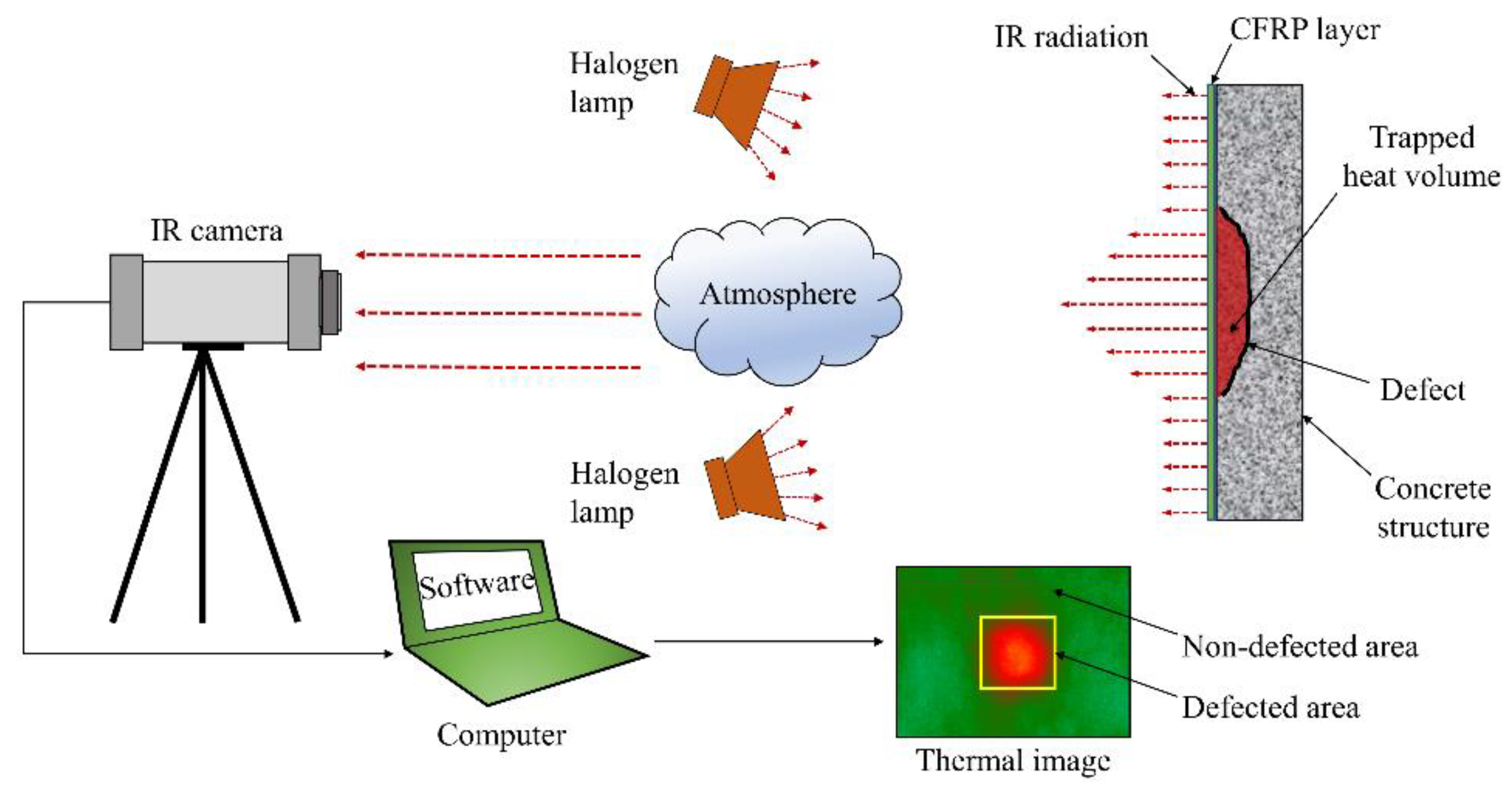
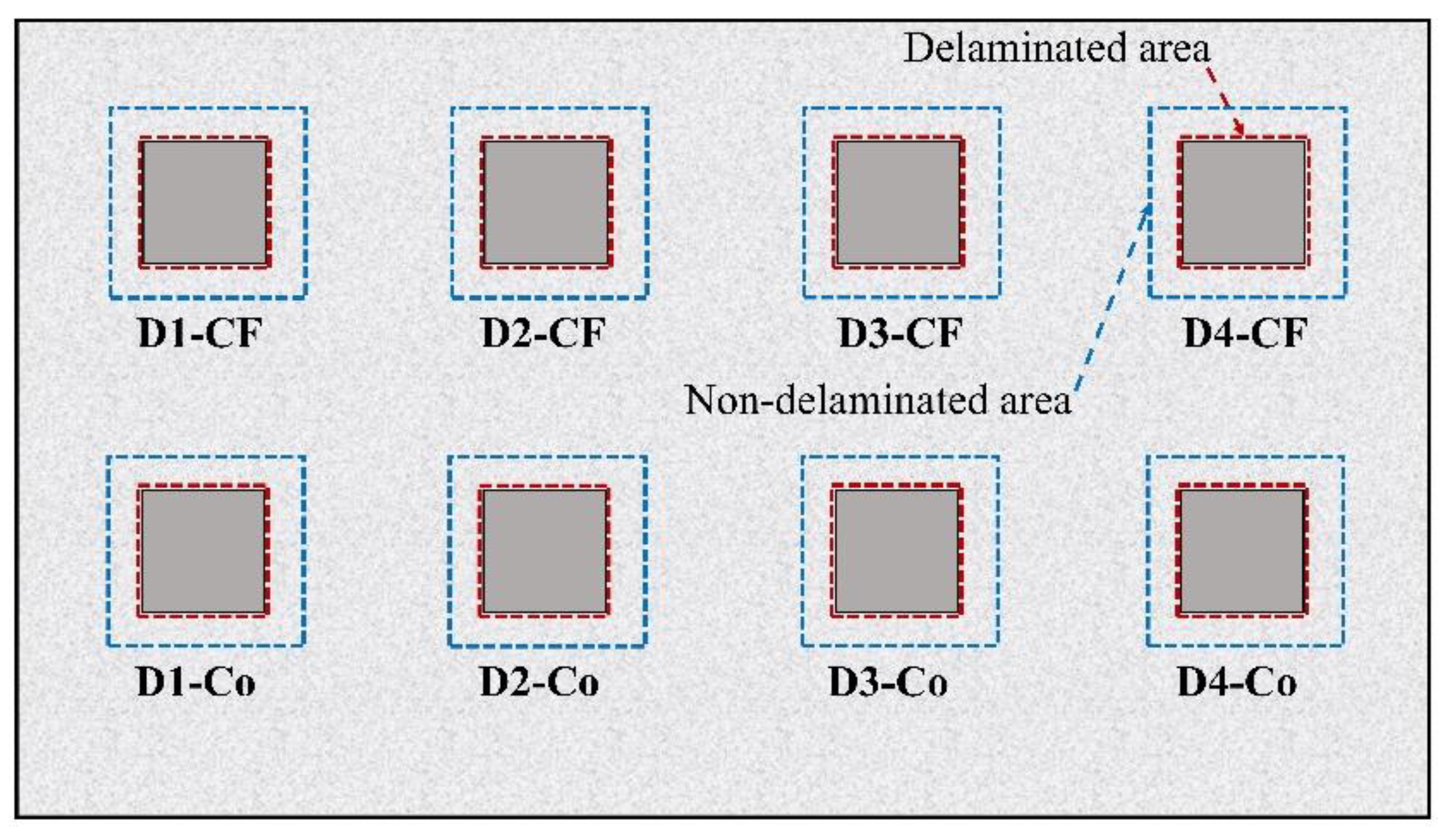
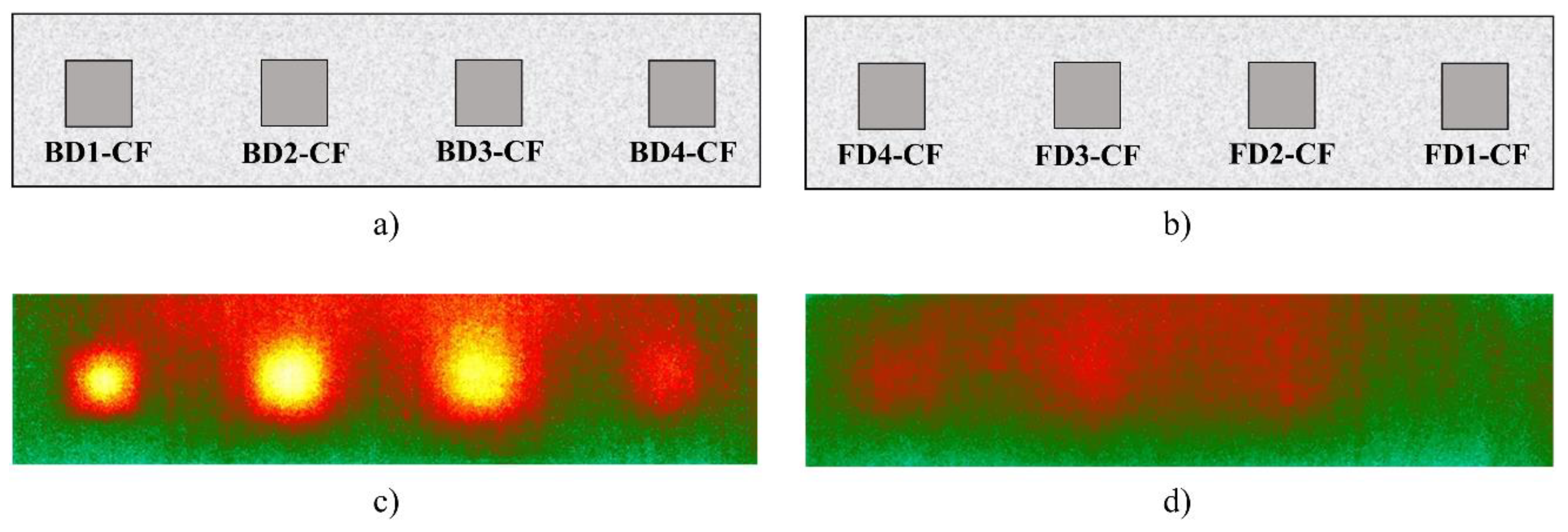
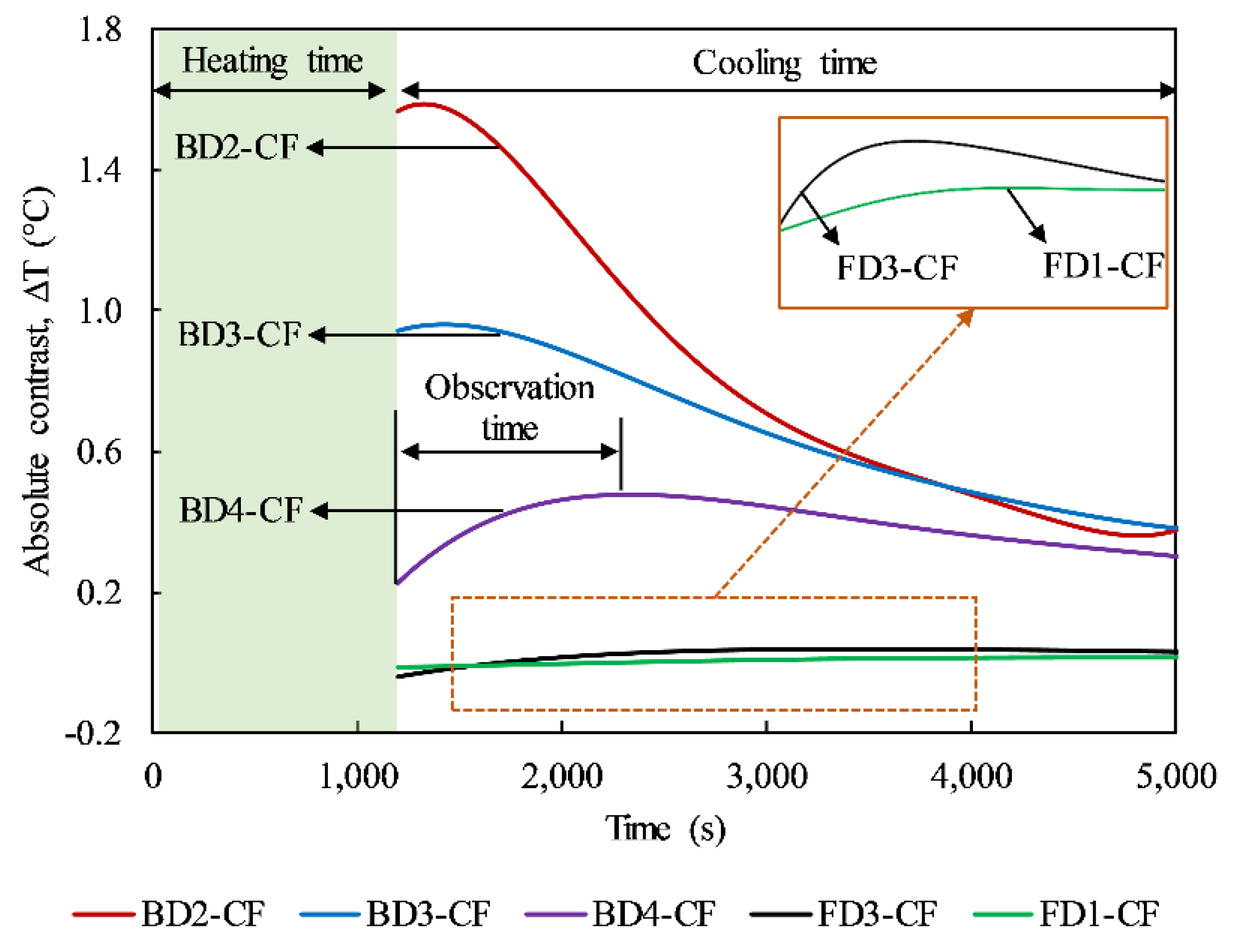

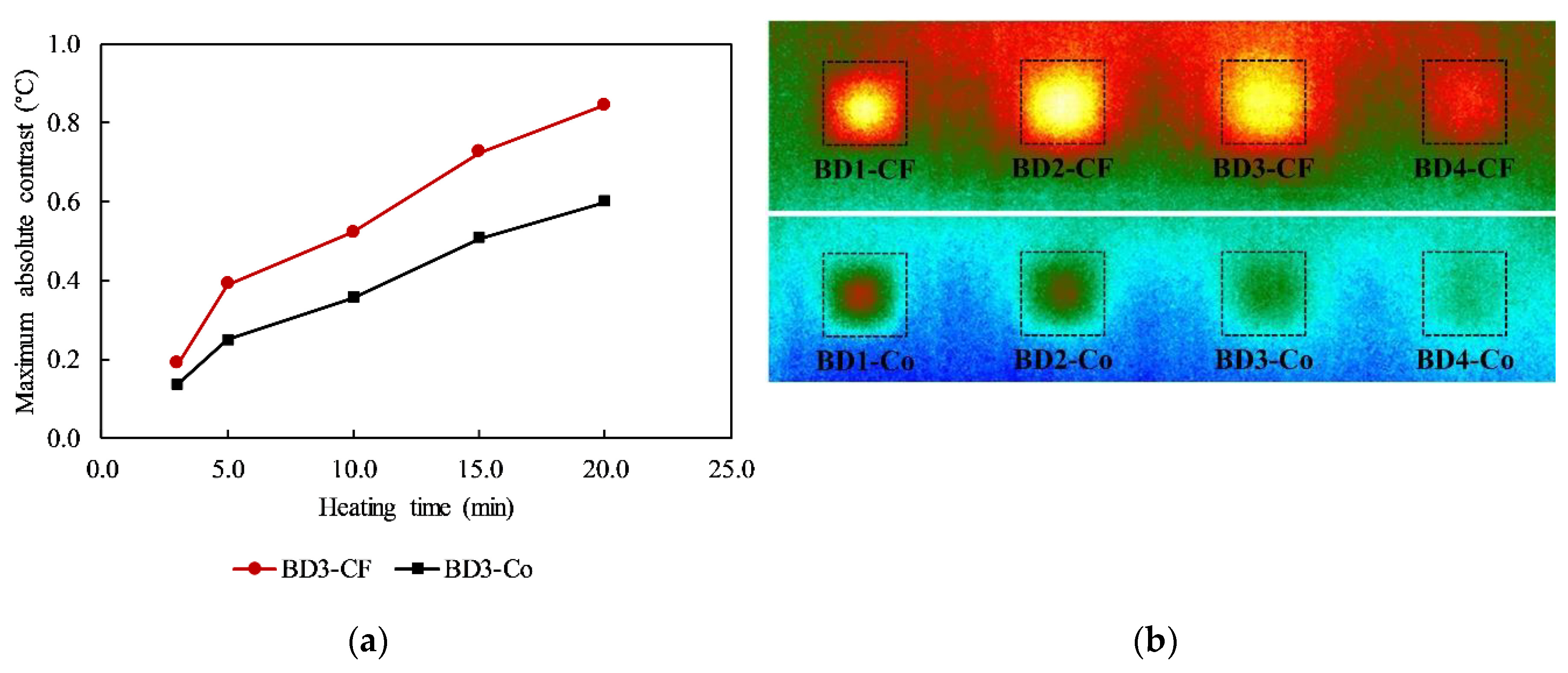

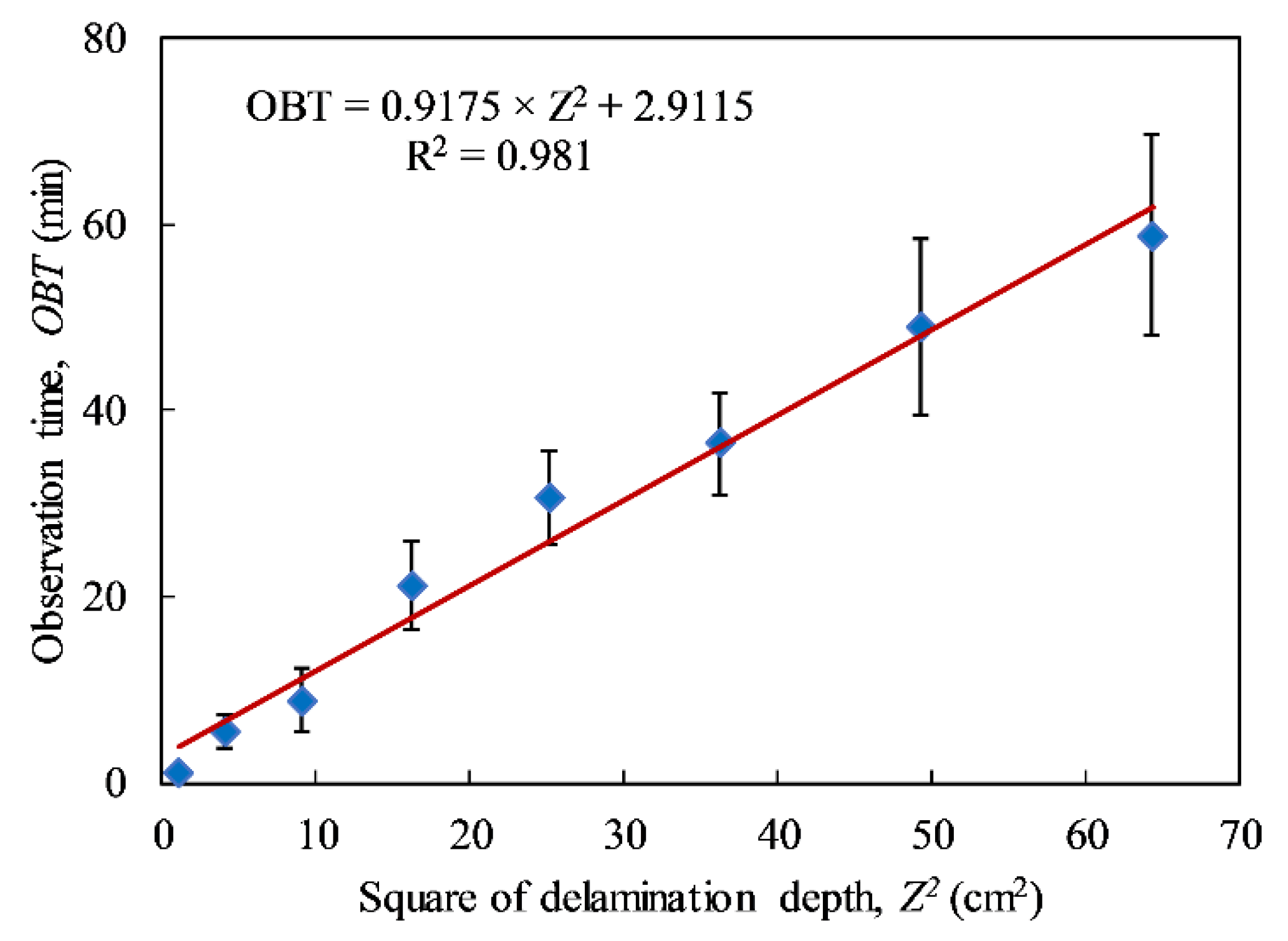


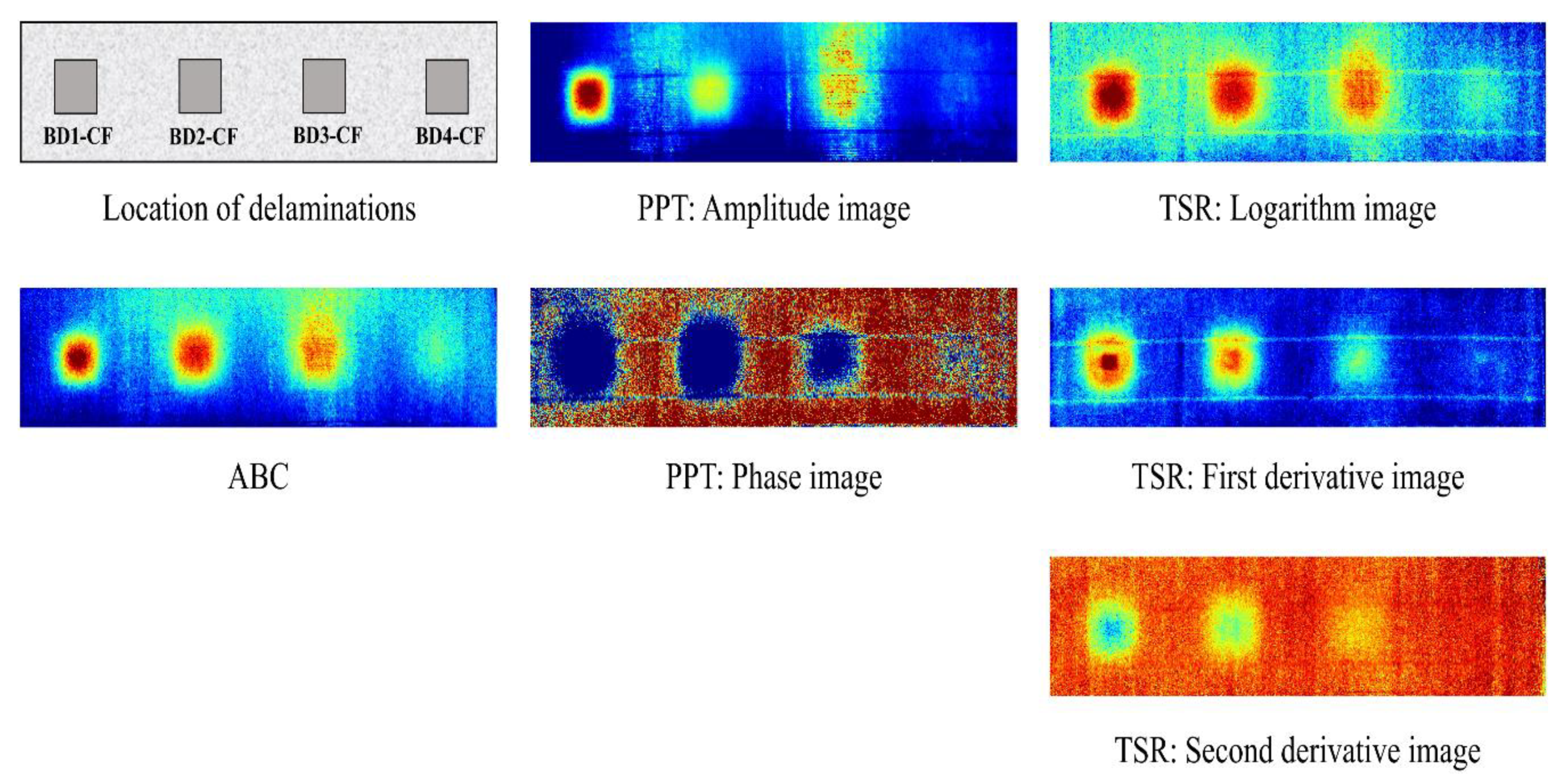
| Defect | Depth (cm) | Testing Face | Structure | Defect | Depth (cm) | Testing Face | Structure |
|---|---|---|---|---|---|---|---|
| BD1-CF | 1.0 | Back | CWC | FD1-CF | 8.0 | Front | CWC |
| BD1-Co | 1.0 | Back | CSC | FD1-Co | 8.0 | Front | CSC |
| BD2-CF | 2.0 | Back | CWC | FD2-CF | 7.0 | Front | CWC |
| BD2-Co | 2.0 | Back | CSC | FD2-Co | 7.0 | Front | CSC |
| BD3-CF | 3.0 | Back | CWC | FD3-CF | 6.0 | Front | CWC |
| BD3-Co | 3.0 | Back | CSC | FD3-Co | 6.0 | Front | CSC |
| BD4-CF | 4.0 | Back | CWC | FD4-CF | 5.0 | Front | CWC |
| BD4-Co | 4.0 | Back | CSC | FD4-Co | 5.0 | Front | CSC |
| Defects | ABC Method | PPT Method | TSR Method | Combination of PPT and TSR Methods | ||||
|---|---|---|---|---|---|---|---|---|
| Amplitude | Phase | Logarithm | First Derivative | Second Derivative | Maximum SNR | Increment Compared to ABC (%) | ||
| 5 min heating | ||||||||
| BD1-CF | 15.36 | 16.31 | 9.79 | 13.52 | 8.87 | 4.00 | 16.31 | 6.22 |
| BD2-CF | 4.98 | 2.01 | 9.74 | 6.83 | 9.49 | 6.11 | 9.74 | 95.42 |
| BD3-CF | 1.90 | 1.61 | 1.17 | 4.61 | 0.19 | −1.87 | 4.61 | 142.60 |
| BD4-CF | −6.01 | −10.75 | −4.07 | −11.07 | −6.00 | −10.80 | −4.07 | 32.23 |
| 10 min heating | ||||||||
| BD1-CF | 18.19 | 16.56 | 10.23 | 16.56 | 15.15 | 12.62 | 16.56 | −8.95 |
| BD2-CF | 10.54 | 5.14 | 13.91 | 10.87 | 14.06 | 10.68 | 14.06 | 33.39 |
| BD3-CF | 5.08 | 1.82 | 3.46 | 5.89 | 4.58 | 2.85 | 5.89 | 16.11 |
| BD4-CF | 2.36 | 0.80 | 0.96 | 0.21 | 1.58 | −0.19 | 1.58 | −33.18 |
| 15 min heating | ||||||||
| BD1-CF | 20.37 | 18.77 | 10.96 | 18.78 | 13.55 | 15.06 | 18.78 | −7.82 |
| BD2-CF | 12.10 | 6.79 | 13.32 | 11.43 | 16.02 | 13.11 | 16.02 | 32.39 |
| BD3-CF | 8.66 | 5.39 | 0.67 | 9.26 | 5.82 | 5.71 | 9.26 | 7.01 |
| BD4-CF | 4.80 | 1.76 | 3.68 | 2.89 | 4.37 | 1.72 | 4.37 | −9.01 |
© 2020 by the authors. Licensee MDPI, Basel, Switzerland. This article is an open access article distributed under the terms and conditions of the Creative Commons Attribution (CC BY) license (http://creativecommons.org/licenses/by/4.0/).
Share and Cite
Mac, V.H.; Huh, J.; Doan, N.S.; Shin, G.; Lee, B.Y. Thermography-Based Deterioration Detection in Concrete Bridge Girders Strengthened with Carbon Fiber-Reinforced Polymer. Sensors 2020, 20, 3263. https://doi.org/10.3390/s20113263
Mac VH, Huh J, Doan NS, Shin G, Lee BY. Thermography-Based Deterioration Detection in Concrete Bridge Girders Strengthened with Carbon Fiber-Reinforced Polymer. Sensors. 2020; 20(11):3263. https://doi.org/10.3390/s20113263
Chicago/Turabian StyleMac, Van Ha, Jungwon Huh, Nhu Son Doan, Geunock Shin, and Bang Yeon Lee. 2020. "Thermography-Based Deterioration Detection in Concrete Bridge Girders Strengthened with Carbon Fiber-Reinforced Polymer" Sensors 20, no. 11: 3263. https://doi.org/10.3390/s20113263








